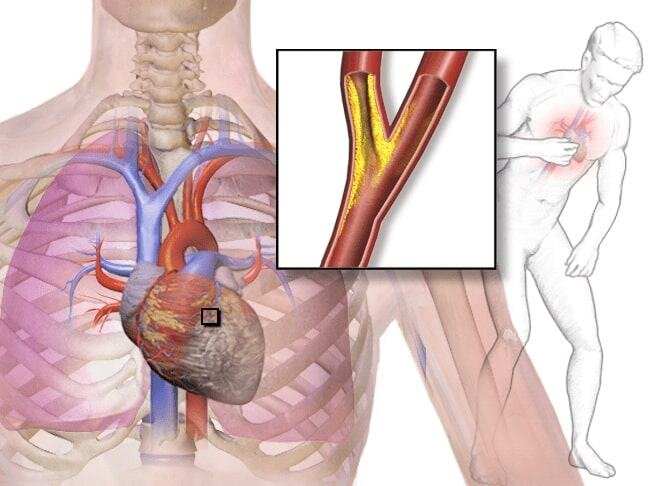Angina Pectoris (Chest Pain)
Angina pectoris, or angina, refers to chest pain that usually appears during exertion or stress. It most often occurs in patients with coronary artery disease. Its appearance is favored by cardiovascular risk factors.
Stable angina pectoris
A stable angina pectoris means that the symptoms only appear when the heart receives less oxygen than necessary, for example in the event of physical exertion, mental load or heavy meal. Signs are an oppressive squeezing or burning sensation behind the sternum, typically radiating to the left arm, but sometimes also to the shoulder, neck, chin, or back. The pain subsides after a few minutes or after taking nitrates.
Unstable angina
In the case of unstable angina, the problems develop over a few hours or a few days, increase rapidly and last more than 15 minutes. They occur for no apparent reason, including at night or at rest. Unstable angina is a warning sign of myocardial infarction, so it is an emergency.
In addition, there are rare, less dangerous forms of angina pectoris, for example microvascular disease (or syndrome X) or Prinzmetal’s angina, which often cause attacks at rest.
Diagram of discomfort caused by coronary artery disease. Pressure, fullness, squeezing or pain in the center of the chest. Can also feel discomfort in the neck, jaw, shoulder, back or arm. Ian Furst, CC BY-SA 3.0, via Wikimedia Commons
The causes of angina
Atherosclerosis most often involved
In 90% of cases, angina pectoris is due to atherosclerosis which reduces the caliber of the coronary arteries. The heart is no longer sufficiently irrigated and the oxygen supply is reduced: we then speak of coronary heart disease or ischemic heart disease. The manifestations of angina appear when the arterial diameter is reduced by at least 50%.
Atherosclerosis is characterized by the appearance of atherosclerotic plaques essentially composed of lipids (cholesterol) which are deposited on the internal wall of the arteries. This process of cholesterol deposition, accompanied by local inflammatory reactions, leads to a modification of the internal wall of the artery which thickens. The evolution of the plaques is long, but it can lead to the complete obstruction of the vessel.
More rarely, other diseases can cause angina pectoris:
- an abnormality of the heart valves,
- cardiomyopathy (disease of the heart muscle),
- the impact on the heart of severe high blood pressure.
Characteristic symptom
Angina pectoris, or angina, refers to chest pain occurring behind the breastbone. It is a constrictive pain, that is to say that the patient has the impression that his chest is taken in a vice. Sometimes the pain is felt in the stomach.
This pain most often occurs during exercise or stress and resolves in about five minutes at rest or after taking trinitrine.
The symptoms are generally obvious but the diagnosis of angina must be confirmed by additional examinations. Angina pectoris is a symptom of heart disease or cardiovascular disease.
The heart muscle lacks oxygen
The right and left coronary arteries and the anterior interventricular are the main vessels supplying the heart muscle. These arteries carry oxygen-rich blood, which is essential for the contraction of the heart muscle. When the oxygen supply is insufficient in relation to the needs of the muscle, the latter suffers and the symptoms of angina pectoris appear.
How does the doctor make the diagnosis of angina pectoris?
If the doctor suspects that the disorder is that of angina pectoris, further tests will be needed. Their purpose is to determine if there are circulatory disorders, how serious they are and which part of the myocardium is affected. There are two different processes:
Non-invasive examinations
These are methods that do not involve penetration into the body. These include the electrocardiogram (ECG), echocardiography, myocardial scintigraphy, magnetic resonance imaging (MRI), scanner (computed tomography, CT).
Invasive examinations
These are methods that involve penetration into the body, for example coronary angiography. They generally require a short hospital stay.
How is angina pectoris treated?
Stable angina requires not only medical treatment, but also the participation of the affected person.
Lifestyle modifications
The basis for an optimal course of the disease is in the hands of the patient. The best drugs and operations will not have good long-term results if the risk factors are not eliminated or treated. Some elements of a healthy lifestyle: do not smoke, have a balanced diet, avoid excess weight, have enough physical activity and no permanent stress.
Drug treatments
Drugs help regulate the heart’s oxygen needs, relieve symptoms of angina, and prevent myocardial infarction. The risk factors of high blood pressure, hyperlipidemia (cholesterol) and hyperglycemia (diabetes) are controlled and, if necessary, treated with medication.
Interventions
Interventions may be needed, it mostly depends on the degree to which blood flow is impeded. One of the most common cardiology procedures is coronary angioplasty, also called balloon dilation. The narrowed coronary artery is dilated using an inflatable balloon mounted on a catheter. Then, a stent is usually placed. Another intervention is bypass surgery.
Information: Cleverly Smart is not a substitute for a doctor. Always consult a doctor to treat your health condition.
Sources: PinterPandai, NHS UK, Mayo Clinic, American Heart Association
Photo credit: BruceBlaus – Blausen.com staff (2014). “Medical gallery of Blausen Medical 2014”. WikiJournal of Medicine 1 (2). DOI:10.15347/wjm/2014.010. ISSN 2002-4436., CC BY 3.0, via Wikimedia Commons

